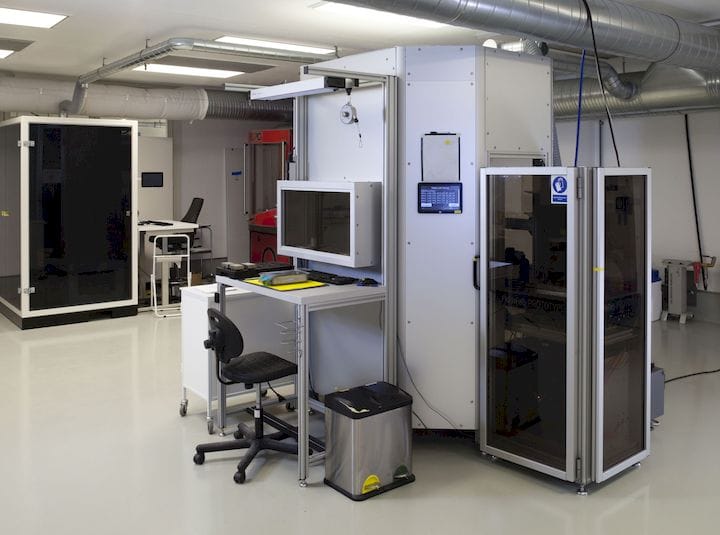![AddiFab’s 3D printer set up in a workshop [Source: AddiFab]](https://fabbaloo.com/wp-content/uploads/2020/05/image-asset_img_5eb08f2bc018b.jpg) AddiFab’s 3D printer set up in a workshop [Source: AddiFab]
AddiFab’s 3D printer set up in a workshop [Source: AddiFab]
Injection molding and 3D printing would seem to be rather different making processes, and they are.
But somehow AddiFab has mixed the two processes together to create something entirely new, which they call “Freeform Injection Molding”. Their process seems to have many of the advantages of both techniques.
The Danish company was formed around 2014, but has been under wraps for most of their existence. We first learned about AddiFab earlier this year, and have been keeping up with their team including a recent rather significant investment.
I was able to speak with AddiFab representatives recently about their technology.
Freeform Injection Molding Process
![Three stages of AddiFab’s Freeform Injection Molding process, from left to right: 3D printing a mold; injected thermoplastic; mold dissolved away [Source: Fabbaloo]](https://fabbaloo.com/wp-content/uploads/2020/05/image-asset_img_5eb08f2c1951f.jpg) Three stages of AddiFab’s Freeform Injection Molding process, from left to right: 3D printing a mold; injected thermoplastic; mold dissolved away [Source: Fabbaloo]
Three stages of AddiFab’s Freeform Injection Molding process, from left to right: 3D printing a mold; injected thermoplastic; mold dissolved away [Source: Fabbaloo]
At its core, their technology is straightforward — although entirely unique in the industry. They have developed an unusual proprietary 3D printable liquid photopolymer resin that can be dissolved completely.
What’s much more complex is how this resin is used in their Freeform Injection Molding process. Here’s how it works:
-
A 3D model of a desired object is created
-
A negative of the 3D model is created — a mold
-
The mold is 3D printed using the special AddiFab resin
-
The print is then placed in an injection molding machine and hot thermoplastic is pressed into the cavities of the print
-
The print/injection combo is placed in a special undescribed solution, where the print dissolves, leaving the completed injection molded part
![A very complex object made with AddiFab’s Freeform Injection molding process [Source: Fabbaloo]](https://fabbaloo.com/wp-content/uploads/2020/05/addifab-complex-print-1_img_5eb08f2c57dcb.jpg) A very complex object made with AddiFab’s Freeform Injection molding process [Source: Fabbaloo]
A very complex object made with AddiFab’s Freeform Injection molding process [Source: Fabbaloo]
![AddiFab’s 3D printer [Source: AddiFab]](https://fabbaloo.com/wp-content/uploads/2020/05/image-asset_img_5eb08f2cb2633.jpg) AddiFab’s 3D printer [Source: AddiFab]
AddiFab’s 3D printer [Source: AddiFab]
I should point out that AddiFab has not only devised this unusual resin, but they have also produced a 3D printer.
This device is said to be made with industrial-grade components and is suitable for factory use, as it includes VOC filtration, safety doors and other features. I’m not sure whether the resin can be used in other 3D printers, but that might be a possibility.
![Front view of AddiFab’s 3D printer [Source: AddiFab]](https://fabbaloo.com/wp-content/uploads/2020/05/image-asset_img_5eb08f2cedf18.jpg) Front view of AddiFab’s 3D printer [Source: AddiFab]
Front view of AddiFab’s 3D printer [Source: AddiFab]
Freeform Injection Molding Benefits
There are some interesting observations about this process:
Since the printed resin is solid and thermally resistant, it can be used with almost any type of commercially used injection molding thermoplastic — including those that are not currently available for 3D printing in other processes.
The injection molding process is very quick, and is literally identical to conventional injection molding — the machine I saw was in fact a common small injection molding device with no modifications.
While the injection is quick, the production of the mold takes the same time as normal 3D prints do: slow. This means the Freeform Injection Molding process cannot replace injection molding for mass production.
Why Use Freeform Injection Molding?
Why use Freeform Injection Molding then? It seems that AddiFab has found an interesting niche: injection mold prototyping.
Normally the process of injection molding first involves the creation of a metal mold. This is a very expensive process and is only worth doing if there is an expectation its cost will be defrayed over many thousands or even millions of units.
The question being solved here is this: “Should I invest in production of an injection mold if I don’t know whether there will be demand for units?”
Prototyping Injection Molding
Using the AddiFab technology it would be possible to inexpensively produce objects virtually identical to proposed injection molded versions without the cost of preparing the metal mold. In this way a business could gauge the demand by making “prototypes” of the proposed item.
These could be made in the final required material, without any of the usual constraints found when 3D printing an object directly.
The Freeform Injection Molding process would allow a business to go into low-volume production for a product in anticipation of a later switch to a proper metal mold for mass production injection molding.
In this way AddiFab creates a kind of “bridge” between the two worlds of low-volume 3D printing and high-volume mass production.
Low-Volume Manufacturing
There’s another use case, which I suspect might be of slightly less interest, and that is ongoing low-volume production of geometrically challenging objects. These would be objects that could not properly be made using conventional injection molding, but require materials not available to 3D printers.
![Metal objects produced with AddiFab’s Freeform Injection Molding process [Source: Fabbaloo]](https://fabbaloo.com/wp-content/uploads/2020/05/image-asset_img_5eb08f2d36516.jpg) Metal objects produced with AddiFab’s Freeform Injection Molding process [Source: Fabbaloo]
Metal objects produced with AddiFab’s Freeform Injection Molding process [Source: Fabbaloo]
Note that the Freeform Injection Molding process works with not only thermoplastics, but also with MIM (Metal Injection Molding) and ceramics as well. This opens up the possibility of using virtually the entire worldwide catalogs of such industrial materials in the process.
After seeing this process first hand, I am very impressed at not only the technology but the ingenious nature of how it has been knitted into the actual workflow of a manufacturing process. It’s no wonder the company has received additional significant investment.
Via AddiFab

